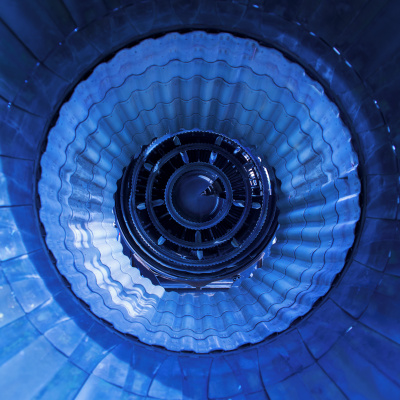Led by Professor Mark Savill, the Power and Propulsion Sciences Group provides advanced, multidisciplinary computational engineering simulation and practical design optimisation applications. We support and extend the work of the Power and Propulsion department across the full range of gas turbine engineering and technology applications. Current areas of research include:
- Aircraft-engine integration and power plant issues to minimise environmental emissions impact;
- Use of biofuels and alternative combustor technologies to meet future targets;
- More efficient turbo-machinery for a wide range of air, sea and land applications;
- The optimal deployment of SMART grid networks for distributed power generation.
Through the latter, we strongly contribute to the Complex Systems Research Centre at Cranfield.
Facilities and resources
We are active in three main areas of research: Computational Engineering Design Optimisation, High Performance Computing and Combustor Modelling and Simulation, with a particular view to addressing performance and environmental issues.
Combustion
- Biofuel Properties, Performance, and Emissions Analyses;
- Combustion Intermittency Studies;
- Helicopter & Other Gas Turbine Combustor Simulations;
- Jet Engine Exhaust Reaction Simulations;
- Micro-Combustor Computational Analyses.
Computational Engineering Design Optimisation
- Aero-Acoustic Optimisation;
- Aero-Thermal Blading and Aerofoil Optimisation;
- Aircraft Icing Optimisation;
- Airframe-Engine Integration and Optimisation;
- Biofuels Optimisation;
- Distributed Power Supply Optimisation via SMART Networks;
- Environmental Impact Optimisation;
- Flow Loading Optimisation;
- Micro-Combustor Design for Manufacture Optimisation;
- Multi-Disciplinary & Multi-Physics Optimisation;
- Multi-Objective Tabu Search Optimisation (MOTS);
- Multi-Objective Genetic Algorithm Optimisation (MOGA);
- Other Complexity Science Applications.
High Performance Computing
- Aircraft Exhaust Plume Mixing and Dispersion Simulation;
- Application of Grid Computing for Distributed Design Optimisation;
- Applied Aerodynamics, Aero-Structural, Aero-Acoustics, Aero-Thermal and Icing High Performance Computing;
- Best Practice Guidelines for Industrial CFD Applications and a Framework for Industrial Application Challenges and their Underlying Flow Regimes;
- DNS to LES to Unsteady/Steady RANS and LBM solutions for gas turbine flows;
- Lattice Boltzmann Methods (LBM) for microfluidic applications;
- Power Systems Integration CFD Modelling;
- Virtual Test Bed and Multi-Dimensional;
- Turbulence Intermittency Modelling for Transition, Mixing and Combusting Flows.
We benefit from access to a wide range of high quality computing resources, both local and national. Using the latest national and local HPC Supercomputer and grid cluster resources, we are able to perform fundamental simulations, which provide both understanding and input to more practical industrial level computational modelling. Additionally, we can utilise the latter for the real complex engineering flow applications encountered in aircraft engine power and propulsion flows. This helps to replace the most expensive experimental testing and incorporate appropriate CFD as part of a more versatile overall design optimisation process.
Current research opportunities
All research degrees require the undertaking of an original piece of work which when completed allows the student to become an expert within this given area. Undertaking a research programme is an individual task which requires personal qualities of self-reliance, determination and dedication. In general, the academic standard required in the thesis for each qualification reflects the period of study. In particular, a PhD thesis should demonstrate significant contribution to learning and the EngD differs in that it includes a formal taught management component. In the Centre for Propulsion and Thermal Power Engineering a wide range of PhD programmes are carried out within the sphere of our industrial and research collaborations.
